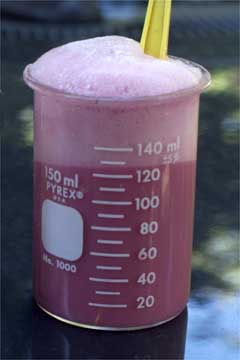December 08, 2004
Dander: froth or scurf?
 Francis Heaney notes another popular eggcorn: get one's gander up, which has 1,070 Google hits, compared to 30,100 for "dander up". Some of the gander examples are witting wordplay -- suburbanites upset about goose droppings, and the like -- but most of them seem to come from people who've misunderstood the idiom, probably because their image of hot anger is better matched by a cranky goose than by cat scurf.
Francis Heaney notes another popular eggcorn: get one's gander up, which has 1,070 Google hits, compared to 30,100 for "dander up". Some of the gander examples are witting wordplay -- suburbanites upset about goose droppings, and the like -- but most of them seem to come from people who've misunderstood the idiom, probably because their image of hot anger is better matched by a cranky goose than by cat scurf.
The OED gives angry dander its own lemma: dander, n.4, glossed as "Ruffled or angry temper; in phr. to get one's dander up, etc." It's said to be "colloq. (orig. U.S.) and dial." The etymology is "[Conjectured by some to be a fig. use of DANDER3, dandruff, scurf; but possibly fig. of DANDER2, ferment.]"
The fermentation-version of dander is apparently a variant of dunder, and is given only one citation:
?c1796 SIR J. DALRYMPLE Observ. Yeast-cake 1 The season for working molasses lasts five months, of which three weeks are lost in making up the dander, that is, the ferment.
Dunder in turn is glossed as "The lees or dregs of cane-juice, used in the West Indies in the fermentation of rum", with the etymology "[Corrupted from Sp. redundar to overflow.]"
The American Heritage Dictionary agrees, explaining angry dander as
Perhaps alteration of dunder, fermented cane juice used in rum-making, fermentation, possibly alteration of Spanish redundar, to overflow, from Latin redundāre. See redundant.
So maybe the original image for someone getting his dander up is the frothy overflowing ferment of yeasty cane-juice. This would be the same metaphor as in the OED's figurative gloss for ferment as "3. agitation, excitement, tumult":
1681 DRYDEN Abs. & Achit. 140 Several Factions from this first Ferment, Work up to Foam, and threat the Government.

The picture shows fermenting grape juice, not cane juice, but the idea is the same. It doesn't look like cats are in the picture at all, however much they may shed when stressed.
Posted by Mark Liberman at December 8, 2004 12:19 AM